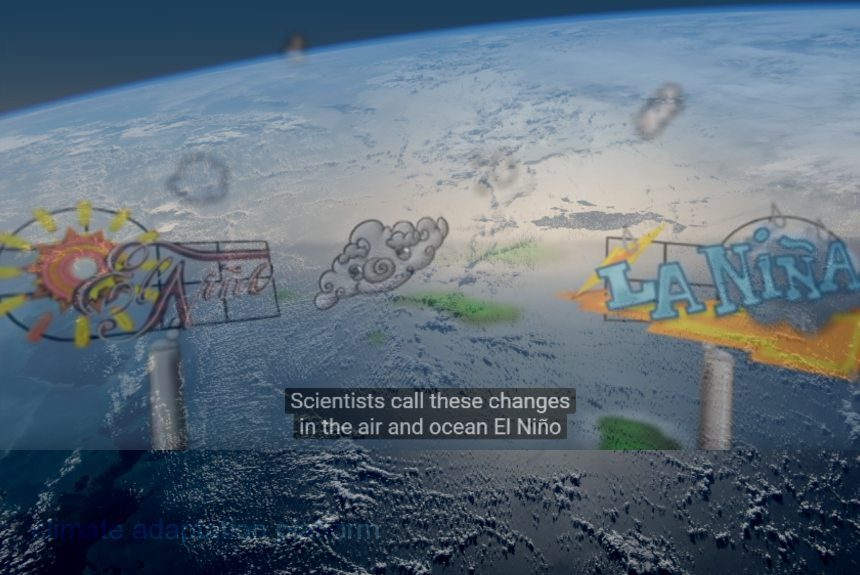The impacts of climate change are already being felt today, disproportionately affecting the most vulnerable members of our community. That is why teaching children about nature and climate change is also important, as it will help them develop a sense of responsibility for their environment and motivate them to act.
But climate change is a complex issue, and other climate patterns, such as El Niño and La Niña, could worsen its effects.
Climate variability from the El Niño and La Niña phenomenon is sometimes challenging to explain to non-scientific audiences, especially children.
Using simple language and visuals as animations can be a powerful medium to break down and explain complex ideas and information.
This happened when animations were used to explain climate variability to the people and children in the Pacific Islands.
The Pacific Climate Animation Project, funded by the Australian Government Pacific Australia Climate Change Science and Adaptation Planning (PACCSAP) science program, has created two animations to explain the El Nino and La Nina phenomena.
The animations are culturally relevant and humorous and use the local backdrop and terminology designed to increase awareness while providing information on how communities can prepare for these climate extremes and variability.
Video 1 – The Pacific Adventures of the Climate Crab
Video 2 – Cloud Nasara
El Niño and La Niña El Niño explained.
“El Niño and La Niña are opposite phases of what is known as the El Niño-Southern Oscillation (ENSO) cycle. The ENSO cycle is a scientific term that describes the fluctuations in temperature between the ocean and atmosphere in the east-central Equatorial Pacific” (“What are El Niño and La Niña,” 2019).
“What are El Niño and La Niña” (2019) explains further that La Niña is the cold phase of ENSO while El Niño is a warm phase. Both phenomena can last up to a year but can sometimes be longer and happen every two to seven years. Changes in ocean surface temperatures can significantly impact both the ocean processes and global weather and climate.
Global Effects of El Nino
Thunderstorms and cyclones develop from warm ocean temperatures, delivering heavy rain. This results in much wetter and stormier conditions in the eastern Pacific while much drier than normal conditions in the western Pacific. More intense cyclones affect the southwest Pacific from Vanuatu east to French Polynesia, while fewer than usual in Indonesia, Papua New Guinea and Australia (“El Niño and La Niña, 2016).
People in the Pacific must understand El Niño and La Niña because scientists believe climate change will intensify its effects (Cho R., 2016).
Andrew Freedman, in his article, “Super El Niño events may become more frequent as the climate warms”, explains:
- Although climate variability such as El Niño and La Niña are not itself climate change, climate change will make El Niño and La Niña more frequent and intensify their impacts, which will mean more extreme rainfalls, flooding, storm surges, saltwater intrusion, and severe and more prolonged droughts as the study shows.
- “Climate change is reshaping the evolution and intensity of El Niño events in a way that favours the occurrence of more “super” El Niños”, from an article citing a study that examined 33 El Niño events from 1901 to 2017.
- According to the study, El Niño is forming and peaking in the Western Pacific, where waters are naturally warmer, which could escalate the event. Consequently, the study observes that climate change is warming the Western Pacific more than the Central Pacific, which can strengthen trade winds blowing from the eastern side to the western side of the Pacific. The warming trend will lead to more frequent Central Pacific-based El Niños and intense El Niño coming from the Western Pacific.
- Because climate change is increasing ocean temperatures, the study predicts El Niño will alter weather patterns worldwide. The study reveals that severe El Niño was experienced in 1982, 1998, and 2015-2016, which created record-high temperatures, killed coral reefs, flooded parts of Asia and Africa, and caused drought in other parts of the world.
The study on climate variability, its relationships to climate change, and its possible effects on weather events gives us a peek at the future. This can guide our climate adaptation and/or mitigation strategies.
Sources:
Compendium of Case Studies on Climate and Disaster p.14-15. (2015). Secretariat of the Pacific Community Geoscience Division. Retrieved from http://gsd.spc.int/frdp/assets/case_studies_pacific.pdf
The Pacific adventures of the climate crab. (2013, July 1). CSIRO [Video file]. Retrieved from https://www.youtube.com/watch?v=sIUSWEftN4w
Cloud Nasara. (2013, August 5). CSIRO [Video file]. Retrieved from https://www.youtube.com/watch?v=AMthanwiOWE
“What are El Niño and La Niña?.” (2019, October 16). National Ocean Service. Retrieved from https://oceanservice.noaa.gov/facts/ninonina.html
“El Niño and La Niña.” (2016). National Institute of Water and Atmospheric Research. Retrieved from https://niwa.co.nz/climate/information-and-resources/elnino
Abraham, J. (2018, August 29). Global warming is intensifying El Niño weather. The Guardian [article]. Retrieved from https://www.theguardian.com/environment/climate-consensus-97-per-cent/2018/aug/29/global-warming-is-intensifying-el-nino-weather
Freedman, A. (2019, October 22). Super El Niño events may become more frequent as the climate warms. The Washington Post [article]. Retrieved from https://www.washingtonpost.com/weather/2019/10/22/super-el-nio-events-may-become-more-frequent-climate-warms/



Leave a Reply